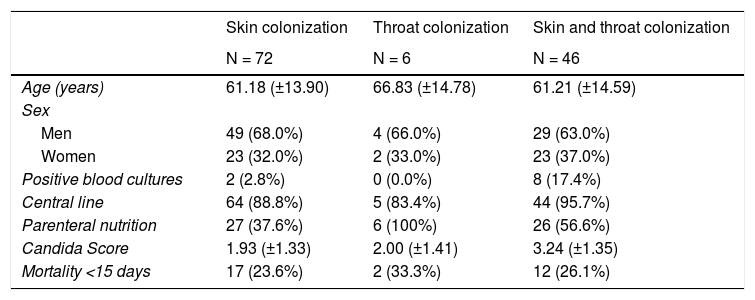Candida auris is a multi-resistant emerging fungus.
ObjectivesTo analyze the relationship between colonization by C. auris and the appearance of invasive candidiasis. Description of the sample of colonized patients, risk factors for colonization and/or infection, and calculation of mortality rates.
MethodologyLongitudinal observational study in an anesthesia intensive care unit in 2018.
Results2130 patients were admitted. Surveillance studies were positive in 124 patients; 118 cases involved skin colonization and 52 were pharyngeal. Patients with a positive blood culture were identified. A statistically significant association was found between pharyngeal colonization and the appearance of a positive blood culture. There were significant differences between patients with a high Candida Score as a risk factor for candidemia. In total, 67% of pharyngeal carriers negativized at 1 month compared to 21% of cutaneous carriers, who negativized after 3–4 months. Of the patients with positive blood cultures, 70% of non-survivors received only monotherapy, although this difference was not statistically significant due to the small sample size.
ConclusionsThe incidence of C. auris, a multi-resistant pathogen that is difficult to diagnose, treat and eradicate, is steadily increasing among critically ill patients. Its status as an emerging threat to global health calls for the urgent implementation of early in-hospital detection systems.
Candida auris es una levadura emergente multirresistente.
ObjetivosAnalizar la relación entre la existencia de colonización por C. auris y la aparición de candidiasis invasora. Descripción de la muestra de pacientes colonizados, factores de riesgo para colonización y/o infección y cálculo de las tasas de mortalidad.
MetodologíaEstudio observacional longitudinal en una Unidad de Cuidados Intensivos de Anestesia durante el año 2018.
ResultadosIngresaron 2.130 pacientes; 124 pacientes tuvieron estudios de vigilancia positivos, 118 casos fueron colonización cutánea y 52 faríngea. Se identificaron los pacientes con hemocultivo positivo. Se encontró asociación estadísticamente significativa entre la existencia de estudio de colonización faríngea y la aparición de hemocultivo positivo. Existieron diferencias significativas en pacientes con Candida Score elevado como factor de riesgo para candidemia. El 67% de portadores faríngeos negativizaron al mes, frente al 21% de los portadores cutáneos que negativizaron tras 3–4 meses. De los pacientes con hemocultivos positivos, el 70% de los fallecidos recibieron solo monoterapia aunque sin alcanzar la significación estadística debido al pequeño tamaño muestral.
ConclusionesC. auris es un patógeno multirresistente con incidencia creciente en el paciente crítico, de difícil diagnóstico, tratamiento y erradicación. Se trata de una amenaza emergente para la salud global, por lo que se debe crear un sistema de detección precoz intrahospitalaria.









